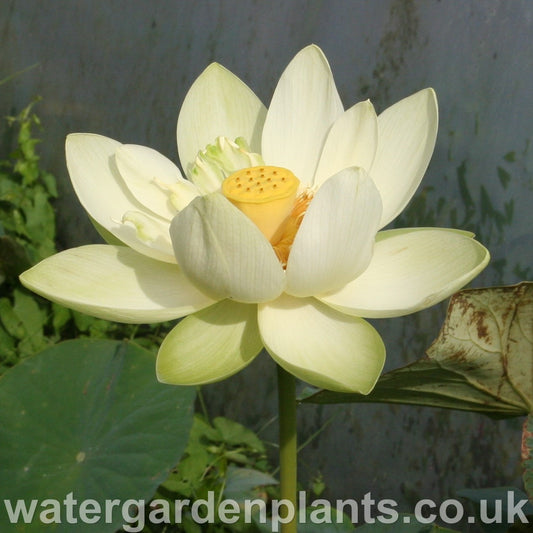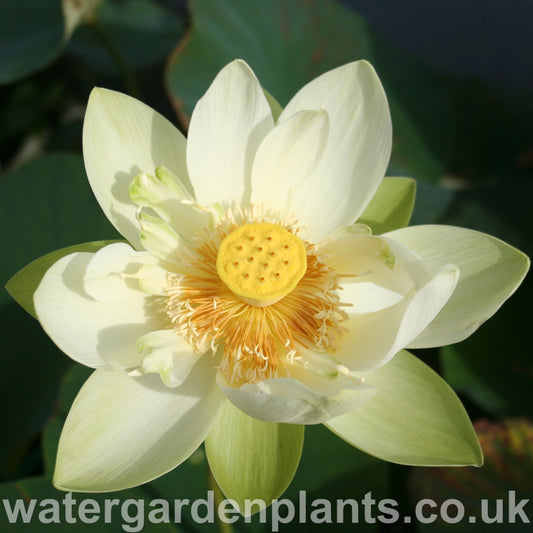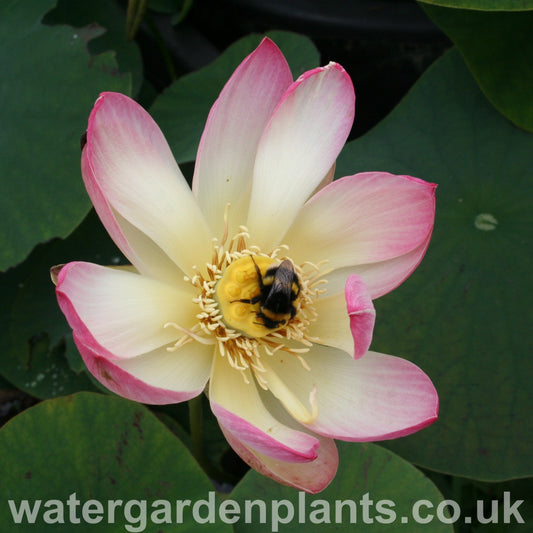Collection: Lotus
Contrary to popular belief it is perfectly possible to grow some varieties of lotus outdoors all year, at least in the southern counties of the United Kingdom. We have been growing them outside here in East Anglia totally unprotected since 1998. We experimented with dozens of different lotus varieties until we found three which successfully grow and flower outside in our climate year after year. All the tubers we sell are our own, grown on the premises here.
They do however need specific growing conditions in order to succeed. It is important to understand that the difficulty with growing lotuses in the UK is our cool summers. Lotuses have no problem with winter cold, but they do need a period of high temperatures in order to bloom and lay down tubers for the following year. So, if you are north of a line stretching from the Severn estuary to The Wash, if you are growing very near the coast, or if you are growing at high altitude, then they will probably not get enough summer warmth to bloom and return from year to year. If your garden is within this geographical area, then the right spot for them is somewhere very sunny and very warm (at least 6 hours direct sunlight per day from April to late September). Also sheltered, so that the heat is retained and the foliage is not damaged by strong winds (rather like the rules for growing tomatoes outdoors). A warm south-facing wall would be ideal.
If you like lotuses but your garden doesn't have anywhere suitable or you're too far north, you can grow them in a well-lit unheated polytunnel or greenhouse. They love the high summer temperatures these produce (although don't allow temperatures to exceed 35°C, since this is too hot even for lotuses). You can also grow them in a polytunnel or greenhouse for most of the year, to benefit from the higher temperatures, and then bring them outside at the height of summer. We have not done this ourselves, but it was done by an RHS garden when growing our lotuses in the north of England.
Lotuses also need different pots from standard aquatic plants. They should always be planted in round containers, because the growing points may be damaged by growing into corners, and this damage can cause the plant to die. For the same reason, do not use open mesh baskets such as traditional aquatic baskets, as the growing points can get stuck in the holes in them - use solid containers. The growing container also needs to be large in order to encourage flowering - we would recommend something at least 45 - 90cm (18 - 36 inches) in diameter and at least 15cm (6 inches) deep. Black containers are best, as these absorb sunlight and warm up the plants more quickly. Because of these requirements, many people choose to plant their lotuses straight into very large round water-tight pots which in effect become a small pond in their own right. This also enables you to pick the exact perfect spot in the garden for them and, particularly if you are in a cooler location, means they will warm up more during the day than if they were in a traditional pond.
Lotus tubers are very brittle and fragile, especially around the growing points (the 'joints' where the shoots emerge). If a tuber snaps in two it will usually survive but will grow less well. However, if it snaps again it will usually die, so unwrap and handle your lotus with great care at all times.
Plant the lotus in heavy clay loam or, if this is not available, shop-bought aquatic soil. Place the tuber horizontally just under the soil - the tuber itself should be buried (otherwise it will float) but the top of the shoots will be poking out. Then place it so that there is 5cm (2 inches) of water over the soil and no more - the plants need as much sun and warmth as possible in order to put on sufficient growth to make tubers for next year, and this is only achieved if they are just under the water surface. When you see emergent leaves, carefully push a couple of slow-release fertiliser tablets into the soil under the tuber (we supply these with the plant).
Flowers appear July to September, depending on how warm a summer we get (in a cool summer the plant may not flower at all; in a hot summer it will flower more). During the winter leave the tuber where it is and it will be fine. It does not need extra protection from frost nor to come into a greenhouse or garage.


Please note there is only a short window to ship lotus tubers, in the spring just before they start to grow. This is usually three or four weeks somewhere between mid February and mid April, depending on the weather.
We usually have many more people wanting lotuses than we can supply; if you would like to buy one we would recommend putting yourself on the 'waiting list' by clicking the notification link on each plant's page. We will offer plants first to those people who have been waiting on the list for the longest.
-

 Out of stock
Out of stockNelumbo 'Mrs Perry D Slocum'
Regular price £39.95Regular priceUnit price / per -

 Out of stock
Out of stockNelumbo 'Perry's Giant Sunburst'
Regular price £49.95Regular priceUnit price / per -

 Out of stock
Out of stockNelumbo 'Pink n Yellow'
Regular price £29.95Regular priceUnit price / per






